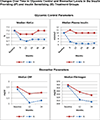BARI 2D: A Reanalysis Focusing on Cardiovascular Events
- PMID: 31590967
- PMCID: PMC6832788
- DOI: 10.1016/j.mayocp.2019.04.015
BARI 2D: A Reanalysis Focusing on Cardiovascular Events
Abstract
Objective: To reanalyze the Bypass Angioplasty Revascularization Investigation 2 Diabetes trial using a new composite cardiovascular disease (CVD) outcome to determine how best to treat patients with type 2 diabetes mellitus and stable coronary artery disease.
Patients and methods: From January 1, 2001, to November 30, 2008, 2368 patients with type 2 diabetes mellitus and angiographically proven coronary artery disease were randomly assigned to insulin-sensitizing (IS) or insulin-providing (IP) therapy and simultaneously to coronary revascularization (REV) or no or delayed REV (intensive medical therapy [MED]), with all patients receiving intensive medical treatment. The outcome of this analysis was a composite of 8 CVD events.
Results: Four-year Kaplan-Meier rates for the composite CVD outcome were 35.8% (95% CI, 33.1%-38.5%) with IS therapy and 41.6% (95% CI, 38.7%-44.5%) with IP therapy (P=.004). Much of this difference was associated with lower in-trial levels of fibrinogen, C-reactive protein, and hemoglobin A1c with IS therapy. Four-year composite CVD rates were 32.7% (95% CI, 30.0%-35.4%) with REV and 44.7% (95% CI, 41.8%-47.6%) with MED (P<.001). A beneficial effect of IS vs IP therapy was present with REV (27.7%; 95% CI, 24.0%-31.4% vs 37.5%; 95% CI, 33.6%-41.4%; P<.001), but not with MED (43.6%; 95% CI, 39.5%-47.7% vs 45.7%; 95% CI, 41.6%-49.8%; P=.37) (homogeneity, P=.05). This interaction between IS therapy and REV was limited to participants preselected for coronary artery bypass grafting (CABG). The lowest composite CVD rates occurred in patients preselected for CABG and assigned to IS therapy and REV (17.3%; 95% CI, 11.8%-22.8%).
Conclusion: In the Bypass Angioplasty Revascularization Investigation 2 Diabetes trial, the IS treatment strategy and the REV treatment strategy each reduces cardiovascular events. The combination of IS drugs and CABG results in the lowest risk of subsequent CVD events.
Trial registration: clinicaltrials.gov Identifier: NCT00006305.
Copyright © 2019 Mayo Foundation for Medical Education and Research. Published by Elsevier Inc. All rights reserved.
Figures



References
-
- Morrish NJ, Wang SL, Stevens LK, et al. Mortality and causes of death in the WHO Multinational Study of Vascular Disease in Diabetes. Diabetologia. 2001;44 Suppl 2:S14–21. - PubMed
-
- Tu B, Rich B, Labos C, et al. Coronary revascularization in diabetic patients: a systematic review and Bayesian network meta-analysis. Ann Intern Med. 2014;161(10):724–32. - PubMed
-
- Toklu B, Bangalore S. Comparison of coronary artery bypass graft surgery and percutaneous coronary intervention in patients with diabetes. Curr Treat Options Cardiovasc Med. 2015;17(5):377. - PubMed
-
- Zinman B, Wanner C, Lachin JM, et al. EMPA-REG OUTCOME Investigators. Empagliflozin, cardiovascular outcomes, and mortality in type 2 diabetes. N Engl J Med. 2015;373(22):2117–28. - PubMed
Publication types
MeSH terms
Substances
Associated data
Grants and funding
LinkOut - more resources
Full Text Sources
Medical
Research Materials

